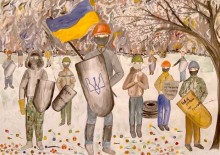The Children’s Art Forum “Golden Easel” which provided works for the exhibition was originally organized on the occasion of the 200th birth anniversary of Taras Shevchenko; however, given the ongoing events in Ukraine, its subject has been changed. The exhibition is also dedicated to the Heavenly Sotnia and all people who are now defending Ukraine’s independence.
“For the past 12 years, the forum held festivals, conferences, competitions, and exhibitions,” the Golden Easel’s curator and founder Olha Mykhailiuk told us. “It was created to bring together children from all over Ukraine and it sees more than 600 contestants annually. This time, our list of 25 finalists included 8 children from Sievierodonetsk. The children wanted to get to Lviv for the final, but they could not leave their city because their parents feared for their lives, they had repeatedly had troubles going through checkpoints, but still they managed to arrive there via Kharkiv.”
The exhibition features drawings by children from across the country, including Lviv, Kerch, Kyiv, Odesa, and Donetsk. They show wide variety of the modern child’s take on important realities of today. Many works are devoted to folk motifs, depicting Ukrainian folk architecture houses, Cossacks on horseback and girls in ethnic costumes. The exhibits also include flowers drawn in the style of Ukrainian folk artists, drawings of interior and coloristics of home, and children’s interpretation of the Cossack Mamai image. The works created on the occasion of the Shevchenko anniversary show him, contrary to the stereotype as an artist and sculptor, while the work placing a portrait of Shevchenko next to an icon of the Virgin indicates the intuitive perception of genius as a canonical person in the consciousness of the Ukrainians.
Children’s take on icons associates them with the image of the Heavenly Sotnia. Children depicted the fallen heroes under the cover of the Virgin or under the protection of St. George the Dragon Slayer. A series of works devoted to the Euromaidan events calls upon us to preserve the memory of the fallen. The drawings are often accompanied by inscriptions “Together to the End,” “There Is No Place in Paradise for Slaves,” and “Heroes Never Die.” Events of the present war in Ukraine are also reflected in the works of young artists, where they are often intertwined with historical motifs of the Cossacks’ freedom fight. Plotless drawings of wreaths with ribbons in the colors of Ukrainian flag, candles, flowers and the words “We Will Never Forget the Heavenly Sotnia” show how important every victim’s actions have remained in the perception of the child. The exhibition also includes graphic works. Folk-inspired works, a story from Shevchenko’s Catherine, a portrait of a Cossack with a horse, elegantly framed with key symbols of Ukrainian culture on the frame – all these impress with their technical achievements, ideological nature, and affinity with the present.
“It is a living art, as children’s works are not dictated by anyone,” director of the Museum of Books and Printing of Ukraine Valentyna Bochkovska remarked. “At the moment, our attention is focused on the events in the anti-terrorist operation area, and such exhibitions show, on the one hand, how sensitive is the inner world of the child, how delicate is their perception of everything, but on the other, they show that the children are looking for a way out of the critical state on their own, trying to figure out where to look for hope, which is a truly heroic endeavor now. It is very important that the children could think about the situation in the country on their own and try to find an explanation for it.”
The exhibition also offers the forum’s magazine, with all funds received from its sales to go to cover the needs of the Ukrainian military in the east of the country. The exhibition will run in Kyiv until October 31, and then it will move to Sievierodonetsk, Kharkiv, and Donetsk.







